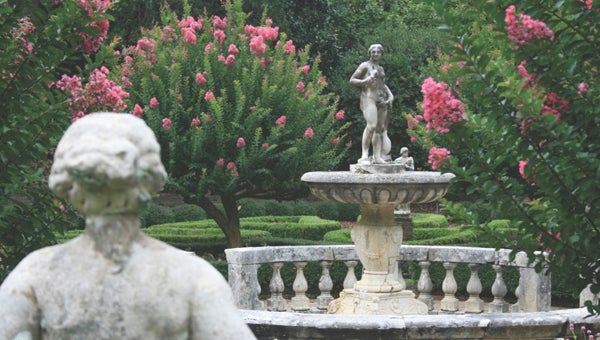Elusive Origins to Gardens’ Renaissance Features: Statuary could be undiscovered work by an Italian master
Published 7:03 pm Tuesday, September 9, 2014
MANTEO — Italians are proud of their classical art, especially the carved marble statues and ornamentals in their historic areas. Several decades ago, Mildred Howard astonished Italians with photos of their beautiful statues tucked within the lush green landscape of a North Carolina sound-side garden. Howard served as board chair of the Manteo attraction in 1957 and 1964 and used a visit abroad to pursue her curiosities. The Italian historians she consulted were unaware these treasures had been relocated to America.
In 1953, the Elizabethan Gardens received several museum-quality Italian statues including a fountain with a pool, wellhead, sundial, birdbaths, stone steps and benches. They were a gift from the Whitney family estate. Gilded-age socialite and famed architectural designer Stanford White imported the items from Pompeii in 1906 for the family as a showcase for their Greenwood Estate in Thomasville, Ga.
The bowl and pedestal Aphrodite Fountain with column balustrade and accompanying statues of Roman gods are now showpieces of the Elizabethan-inspired sunken garden in Manteo where millions have enjoyed them for over 60 years.
“We know how the statues came to be here,” commented Carl Curnutte, executive director of the Elizabethan Gardens, “But exactly where these Italian statues originated is a mystery to us. There is simply no known account of who carved them, where they were found in Italy and why they would send them abroad.”
While Howard hoped to find out more from her travels, she returned without answers.
Perhaps Howard was onto something.
During the time he imported these statues, White was designing and decorating the Whitney’s New York City home, built from 1902 to 1906. A curious statue White placed in this Manhattan residence garnered the attention of art scholars recently. Today they think that statue is a work by Michelangelo.
Could the Gardens’ statues also be by the same classical master? Markings may hold a clue.
Carved on the balustrade in the Sunken Garden is the 15th century Farnesi family crest. Several important architectural works are associated with the powerful family including the Palazzo Farnese in Rome and the Villa Farnese at Caprarola. Incidentally, this wealthy family was a patron to artist Michaelangelo, who designed the façade of the Palazzo Farnese.
Perhaps Howard had good evidence to believe the Gardens statues could also be by Michelangelo, or a contemporary. She claimed to have located museum drawings of a fountain he placed in the Farnese gardens — a fountain and balustrade similar to the one at the Elizabethan Gardens.
“She might be right,” added Curnutte. “An inventory of art undertaken by the Smithsonian Museum claims that the Gardens’ statues were once at the Farnese Palace. It estimated their dates to be anywhere from 1300 to 1699.”
“The story goes that these sunken garden statues, and others from the estate, were to be sent to the Metropolitan Museum,” said Curnutte. “But someone convinced the Whitney family that an ambitious project started by the North Carolina Garden Club might be a worthy site. We are very grateful they came our way.”
While unique, these statues aren’t the only works of art with illusive origins at the Elizabethan Gardens. In 2012, forensic investigations of a Queen Elizabeth I portrait owned by the gardens determined the work has Elizabethan origins. Investigators were amazed that this particular portrayal of the aged ruler had survived stringent royal censors.
“Ours is truly a garden of incredible gifts,” said Sandra Snapp, chair of the Board of Governors for the Garden. “We are humbled that supporters donated these statues, the Queen Elizabeth I painting, antique furniture in our collection and even some of our plants. Their generous heart and eye for beauty are to be commended. They are an important part of our heritage.”
While no plans are in the works to investigate the origin of the statues further, the Gardens hopes to take a step toward preserving them.
“The salt air and harsh outdoor environment have dealt a hard blow to the antique works of art,” said Curnutte. “Preservation, while important, is very costly,” he added. “A Save Outdoor Sculpture survey by the Smithsonian in 1994 indicated treatment was needed. Twenty years have passed since then. While these historical works are valuable to us, we can only work within our means to protect them.” He continued, “Supporters who wish to assist the Gardens with efforts to preserve and protect their valuable collection are encouraged to contribute to the Annual Fund.”
Nestled among the typical coastal scenery, The Elizabethan Gardens and its impressive statuary and plants are a unique gem. While visiting there one may even have a sense they are in a European garden, not a sound-side coastal garden.
To see the statues and the tapestry of seasonal plantings that frame them you’ll have to travel to Manteo, North Carolina on Roanoke Island, nestled among the Outer Banks. Visitation is by paid admission. The Gardens are open yearlong, seven days a week. Hours vary seasonally. For more information visit elizabethangardens.org or call 252-473-3234.






